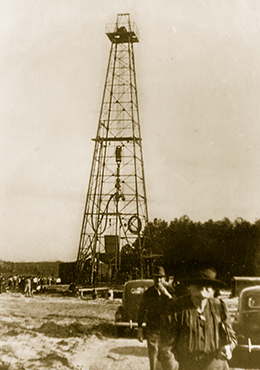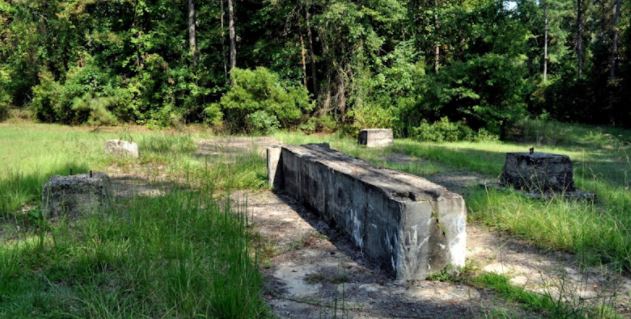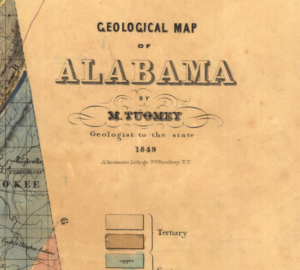This Week in Petroleum History: February 12 – 18
February 12, 1954 – First Nevada Oil Well –
After hundreds of dry holes (the first drilled near Reno in 1907), Nevada became a petroleum-producing state. Shell Oil Company’s second test of its Eagle Springs No. 1 well in Nye County produced commercial amounts of oil. The routine test revealed petroleum production from depths between 6,450 feet and 6,730 feet.

Nevada’s annual oil production peaked in 1990 at about 4 million barrels of oil. Chart courtesy Nevada Division of Minerals.
Although the Eagle Springs field eventually produced 3.8 million barrels of oil, finding Nevada’s second oilfield took two more decades. Northwest Exploration Company completed the Trap Spring No. 1 well in Railroad Valley, five miles west of the Eagle Springs oilfield in 1976.
Learn more in First Nevada Oil Well.
February 12, 1987 – Texaco Fine upheld for Getty Oil Takeover attempt
A Texas court upheld a 1985 decision against Texaco for having initiated an illegal takeover of Getty Oil after Pennzoil had made a bid for the company. By the end of the year, the companies settled their historic $10.3 billion legal battle for $3 billion when Pennzoil agreed to drop its demand for interest.
According to the Los Angeles Times, the compromise was vital for a reorganization plan for Texaco emerging from bankruptcy, a haven it had sought to stop Pennzoil from enforcing the largest court judgement ever awarded at the time.
February 13, 1924 – Forest Oil adopts Yellow Dog Logo
Forest Oil Company, founded in 1916 as an oilfield service company by Forest Dorn and his father Clayton, adopted a logo featuring the two-wicked “yellow dog” oilfield lantern. The logo included a keystone shape to symbolized the state of Pennsylvania, where Forest Oil pioneered water-flooding methods to improve production from the 85,000-acre Bradford oilfield.
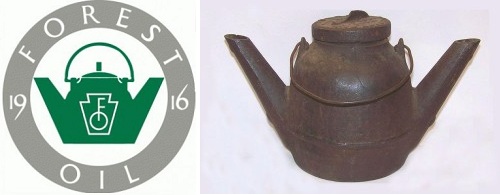
Forest Oil Company adopted the “yellow dog” lantern logo in 1924. eight years after being founded in Bradford, Pennsylvania,
Forest Oil Company‘s oilfield water-injection technology, later adopted throughout the petroleum industry, helped keep America’s first billion dollar oilfield producing to the present day. Patented in 1870, the popular derrick lamp’s name was said to come from the two burning wicks resembling a dog’s eyes glowing at night.
Learn more in Yellow Dog – Oilfield Lantern.
February 13, 1977 – Texas Ranger “El Lobo Solo” dies
“El Lobo Solo” — The Lone Wolf — Texas Ranger Manuel T. Gonzaullas died at age 85 in Dallas. During much of the 1920s and 1930s, he had earned a reputation as a strict law enforcer in booming oil towns.

Texas Ranger Manuel Gonzaullas’ “working pistols” had the trigger guard cut away.
When Kilgore became “the most lawless town in Texas” after discovery of the East Texas oilfield in 1930, Gonzaullas was chosen to tame it. “Crime may expect no quarter in Kilgore,” the Texas Ranger once declared. He rode a black stallion named Tony and sported a pair of 1911 .45 Colts with his initials on the handles.
“He was a soft-spoken man and his trigger finger was slightly bent,” noted independent producer Watson W. Wise in 1985. “He always told me it was geared to that .45 of his.”
Learn more in Manuel “Lone Wolf” Gonzaullas, Texas Ranger
February 15, 1982 – Deadly Atlantic Storm sinks Drilling Platform
With rogue waves reaching as high as 65 feet during an Atlantic cyclone, offshore drilling platform Ocean Ranger sank on the Grand Banks of Newfoundland, Canada, killing all 84 on board. At the time the world’s largest semi-submersible platform, the Ocean Ranger had been drilling a third well in the Hibernia oilfield for Mobil Oil of Canada.
The deadly weather system also engulfed a Soviet container ship 65 miles east of the platform, resulting in the loss of 32 crew members. Recommendations from the 1983 U.S. Coast Guard report would lead to improved emergency procedures, lifesaving equipment, and manning standards for other Offshore Mobil Drilling Unit (MODU) operations.
February 16, 1935 – Petroleum Producing States form Commission
A multi-state government agency that would become the Interstate Oil and Gas Compact Commission was organized in Dallas with adoption of the “Interstate Compact to Preserve Oil and Gas.” Approved by Congress in August, the commission established its headquartered in Oklahoma City.
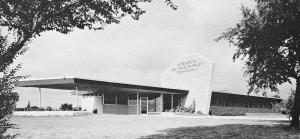
The Interstate Oil and Gas Compact Commission has been based in Oklahoma City since the mid-1930s.
Representatives from Colorado, Illinois, Kansas, New Mexico, Oklahoma and Texas began planning initiatives, “to conserve oil and gas by the prevention of physical waste thereof from any cause.” Oklahoma Gov. Ernest W. Marland — founder of Marland Oil Company in 1921 — was elected first chairman.
“Faced with unregulated petroleum overproduction and the resulting waste, the states endorsed and Congress ratified a compact to take control of the issues,” according to IOGCC, which added the word gas to its name in 1991.
February 17, 1902 – Lufkin Industries founded in East Texas
The Lufkin Foundry and Machine Company was founded in Lufkin, Texas, as a repair shop for railroad and sawmill machinery. When the pine region’s timber supplies began to dwindle, the company discovered new opportunities in the burgeoning oilfields following the 1901 discovery at Spindletop Hill.
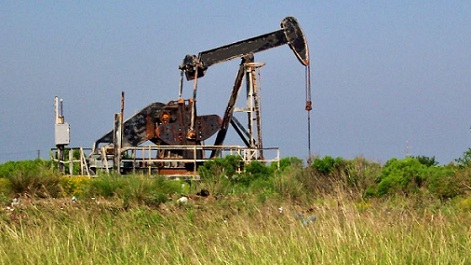
A Lufkin counter-balanced oil pump near Beaumont, Texas, in 2003. Photo by Bruce Wells.
Inventor Walter C. Trout was working for this East Texas company in 1925 when he came up with a new idea for pumping oil. His design would become an oilfield icon known by many names — nodding donkey, grasshopper, horse-head, thirsty bird, and pump jack, among others.
By the end of 1925, a prototype of Trout’s pumping unit was installed on a Humble Oil and Refining Company well near Hull, Texas. “The well was perfectly balanced, but even with this result, it was such a funny looking, odd thing that it was subject to ridicule and criticism,” Trout explained.
Learn more in All Pumped Up – Oilfield Technology.
February 17, 1944 – H.L. Hunt discovers First Alabama Oilfield
Alabama’s first oilfield was discovered in Choctaw County when independent producer H.L. Hunt of Dallas, Texas, drilled the No. 1 Jackson well. Hunt’s 1944 wildcat well revealed the Gilbertown oilfield. Prior to this discovery, 350 dry holes had been drilled in the state.
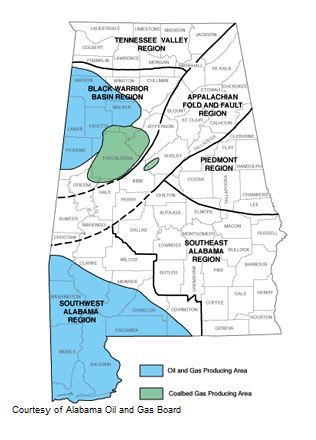
Alabama’s major petroleum producing regions are in the west. Map courtesy Encyclopedia of Alabama.
According to research by petroleum geologist Ray Sorenson, an 1858 report first noted Alabama natural oil seeps about six miles from Oakville in Lawrence County (see Exploring Earliest Signs of Oil). Hunt’s discovery well was drilled in Choctaw County, where he revealed the Gilbertown oilfield at a depth of 3,700 feet.
Although it took 11 years for another oilfield discovery, new technologies and deeper wells in the late 1980s led to the prolific Little Cedar Creek and Brooklyn fields. By the mid-2000s, geologic assessments were underway for the potential of the shales of St. Clair and neighboring counties.
Learn more in First Alabama Oil Well.
_______________________
Recommended Reading: Roadside Geology of Nevada (2027); The Taking of Getty Oil: Pennzoil, Texaco, and the Takeover Battle That Made History
(2017); Images of America: Around Bradford
(1997); Lone Wolf Gonzaullas, Texas Ranger (1998); Lufkin, from sawdust to oil: A history of Lufkin Industries, Inc.
(1982); Lost Worlds in Alabama Rocks: A Guide
(2000). Your Amazon purchase benefits the American Oil & Gas Historical Society. As an Amazon Associate, AOGHS earns a commission from qualifying purchases.
_______________________
The American Oil & Gas Historical Society (AOGHS) preserves U.S. petroleum history. Please support energy education, help maintain the AOGHS website, and expand historical research for scribers to the monthly “Oil & Gas History News.” For more information, contact bawells@aoghs.org. Copyright © 2024 Bruce A. Wells. All rights reserved.



